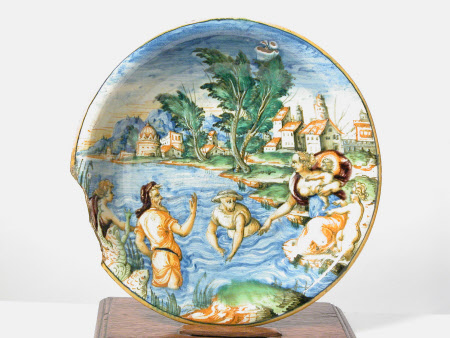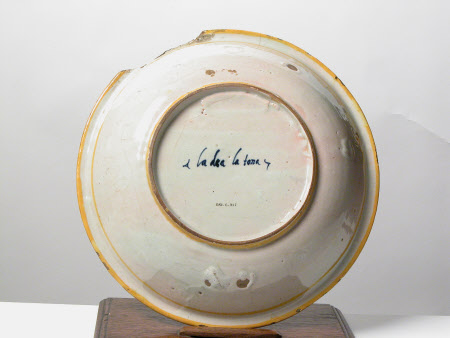Dish
Category
Ceramics
Date
1575 - 1600
Materials
earthenware, tin-opacified lead glaze, polychrome pigments
Measurements
305 mm (Dia)
Order this imageCollection
Erddig, Wrexham
NT 1145575.1
Summary
Dish, tin-glazed earthenware (maiolica), shallow bowl with rounded rim, made in Urbino, Italy, 1550-1600; decorated in colours and painted with an istoriato scene from Ovid’s Metamorphoses, the story of Latona (or Leto) and the Lycians, in which Latona kneeling by a river holding a child with another beside her, turned bathing peasants into frogs as punishment for muddying the stream from which she wished to drink, in an extensive landscape with a village in the distance; the underside inscribed 'la dea la tona' [Trans. The Goddess Latona].
Full description
The print source is a woodblock print by Barnard Salomon (1506/10-c.1561), illustrating La Metamorphose d'Ovide figvree, Lyon, 1557, plate entitled 'Les païsans en grenouilles'. The same image was also used on a maiolica dish at the Victoria and Albert Museum, London, (inv. no. 8911-1863); however, the same subject on a dish at Knighthayes Court, Devon, NT 540405, is based on a different source. Discussed in J.V.G. Mallet, 'Pottery and Porcelain at Erddig', Apollo, July 1978, pp.40-45; and see also Louisa Matilda Yorke, Facts and Fancies: A Description of Erthig, Denbighshire, 1920s, p. 14. The dish and another are listed in the 1914 inventory of the China and Pottery at Erthig (Erddig): 'Two deep round Dishes. One representing Venus in a shell on the Sea and three Cupids, etc. The other representing Jupiter, Juno and Cupids etc. This dish has a piece missing'.
Provenance
Given by Philip Yorke III (1905-1978) along with the estate, house and contents to the National Trust in 1973.
Marks and inscriptions
On the base: < la dea la tona >

